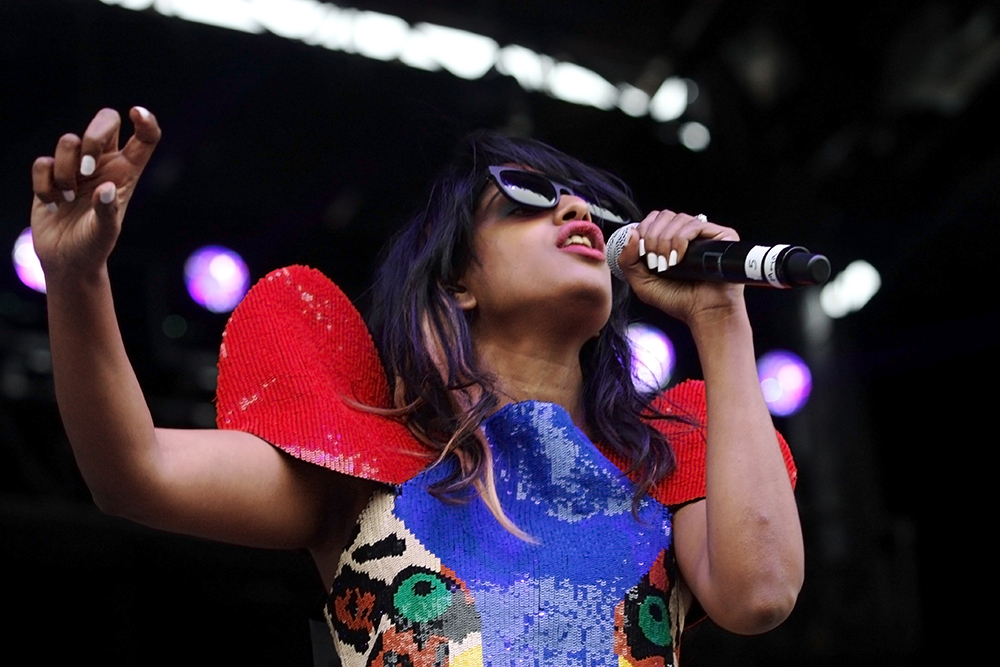
Before Maya Arulpragasam became the genre-bending rapper M.I.A., she dreamed of being a documentary filmmaker and hoped to chronicle narratives she rarely saw, like those of her family, Tamil people, and other marginalized communities.
Now, viewers can get a glimpse of that world with new documentary Matangi/Maya/M.I.A. by director Stephen Loveridge, which premieres at the Parkway Theatre on Friday, October 19. The film offers new insights about the life, trials, and activism of an artist whose sound ruled the early 2000s.
In the film, we learn that her father was a Sri Lankan revolutionary, a founding member in the Tamil Resistance Movement, a collective who fought against the genocide of the Tamil people. In 1995, when Maya was 10 years old, she and her family were forced to flee Sri Lanka, and emigrate to an immigrant ghetto in Britain. While there, Maya was exposed to struggles of other peoples and found a particular connection to the African-American experience through hip-hop and by reading anti-colonial literature from scholars like Frantz Fanon.
One of the highlights of the documentary is its inclusion of behind the scene footage of M.I.A. traveling around the world to gather sounds for her second album, Kala. In an effort to produce a truly global sound, M.I.A. worked with musicians in Sri Lanka, Trinidad, Jamaica, Central Africa and Black America, with significant time spent in Baltimore. One thing that always drew me to the soundscapes M.I.A. produced on Kala was the bass and meter it sourced from Baltimore Club. It is no surprise that Philadelphia-bred producer Diplo was highly influenced by Baltimore Club and reached out to legendary Baltimore-based producer Blaqstarr to work on cuts for M.I.A.’s second album, Kala. Tracks written and produced by Blaqstarr include “The Turn” and “World Town,” which incorporated elements from Blaqstarr’s classic banger, “Hands Up Thumbs Down.”
Music aside, the film’s recurrent theme is that of conflict—M.I.A.’s struggle to find balance between the privilege and ambivalence of celebrity, and her self-imposed responsibility to, like her father, use her platform as a vehicle to address devastating civil injustices in Sri Lanka. Family photographs, found footage, and documentary video shot by Maya, intercut with more recent footage by Loveridge, a longtime friend and early art school classmate, reveal the artist’s eminent failure to leverage her celebrity for the freedom of Tamil people and also maintain her celebrity.
Every culture has a caste system, an “othered” population that usually has a darker complexion, follows a religious system other than Christianity or a belief that is outside of the Abrahamic religious structure, or is a different ethnic group or class than the nations ruling class. The documentary reveals that, despite these global inequities, people, especially those from so-called first world nations, quickly forget that we are implicated by our avoidance to combat systemic inequalities.
In 2010, around the release of Maya, an album notoriously reviled for its visceral music video “Born Free,” which depicted the violence of genocide by using white, red-haired victims in place of people of color, M.I.A. went on a media tour to call out the Sri Lankan governments participation in the genocide of Tamil people. The response was anything but favorable. Major media outlets including The New York Times and The Guardian, among others, quickly mocked and discredited her motives. In many ways Matangi/Maya/M.I.A. seems to try to shift the narrative away from that gas lighting, and the perception that M.I.A. was merely an airheaded, unintellectual persona, towards a more realized and historically nuanced reflection, in the artist’s own words, about her journey to become M.I.A. and her persistent support for the freedom and protection of Tamil people.
The documentary is a slow burn that leaves a lasting impression about how quickly one’s politics can make them fall out of favor with popular culture.